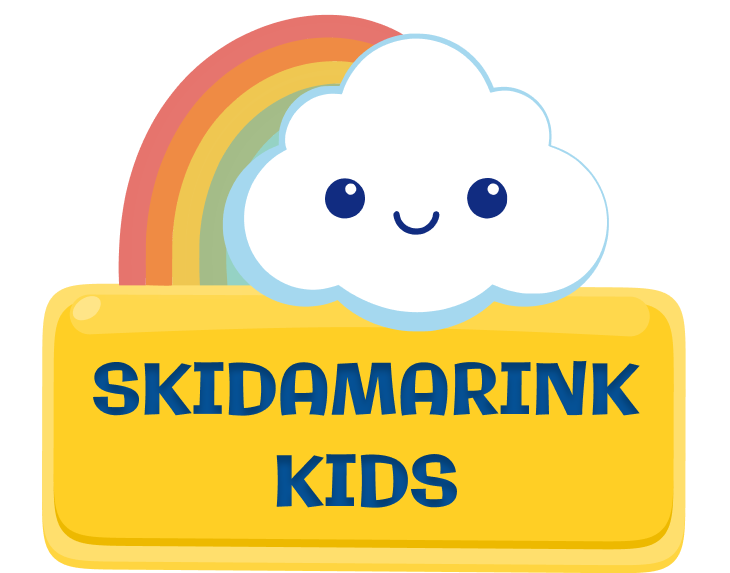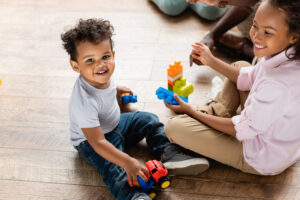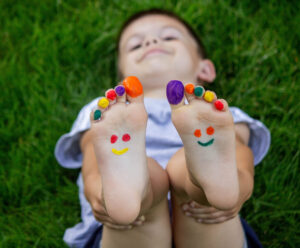Have you ever wondered why your child can’t sit still, struggles with focus, or seems overwhelmed by simple tasks? You’re not alone, and there’s a deeper reason behind these behaviors that many parents don’t realize. This developmental play guide will help you understand what your child’s behavior is really telling you and how to choose the right activities to support their growing brain.
One of the most important things to understand is that children today are getting too much left brain stimulation far too early. This helps answer that burning question: “Why my child doesn’t sit still?”
Understanding the Brain Balance Crisis
When we push left brain activities like fine motor toys or academic learning toys before the right brain has a solid foundation, we’re actually making it harder for their developing minds to learn well. We think we’re giving them the best start in life. But in reality, we may be adding to attention problems and developmental delays.
The Right Brain Needs to Develop First
The right brain needs to develop first. It’s our foundation for body awareness, motor coordination, social and emotional control, verbal communication, creativity, and the ability to stay calm and focused. This right brain development is especially critical during the first two years of life.
From birth to age 2, your child’s brain is mainly focused on building these basic right brain skills through sensory experiences, movement, and emotional connection.
What Babies and Toddlers Really Need
During this crucial window, babies and toddlers need lots of cuddling, rocking, singing, big body movement, and face to face interaction. This is opposite of what we tend to focus on. Educational toys, videos, or academic activities activate the left side of the brain.
When children receive too much left brain stimulation too early (even as babies), their nervous system becomes overwhelmed. This leads to the fidgety, unfocused behaviors and meltdowns that worry so many parents later on. This can also cause developmental delays, ADHD, and autism.
Your Complete Developmental Play Guide for Reading Behavior
Learning to read your child’s behavior is like becoming a detective. Their actions, reactions, strength and struggles are actually giving you valuable clues about which side of their brain needs more support.
Signs Your Child Needs More Right Brain Development
All infants and toddlers (birth to 2 years) benefit from right brain focused activities since this is their primary developmental window to lay a good foundation which will support brain balance. For these little ones, right brain building through loving interaction, movement, play, and sensory exploration is exactly what their growing brains need most.
Behaviors That Signal Right Brain Needs
For older children, your child likely needs more basic, right brain building activities if they are displaying some of the following behaviors (especially more than their peers):
Can’t sit still or constant movement – This often signals that their right brain foundation isn’t strong enough to support calm, focused attention
Extreme emotional meltdowns over small things or during transitions – Right brain weakness affects emotional control
Trouble with coordination or seems clumsy – The right brain handles big body movements and body awareness
Gets overwhelmed in busy places – Right brain helps us filter and organize sensory information
Can’t follow simple multi-step directions – Without right brain foundation, the left brain can’t process complex information well
Shows delays in speech and communication – The right side of the brain is the foundation for verbal communication
Lacks social awareness, empathy, or imitation skills – Social interactions including reading facial expressions, eye contact, and imitation skills are controlled by the right side of the brain
Play involves mostly lining up objects or focusing on details – “Big picture” ideas are controlled by the right side of the brain, versus the left side which is detail focused and fine motor oriented
Understanding What This Means
This information is not meant to worry you or for diagnosis purposes. Rather, it’s to empower you to know how to use play to activate the part of the brain that may need to be stronger. This will make it easier for your child to focus, have self control, communicate, show empathy, and improve their motor coordination.
This developmental play guide approach will reduce sensory issues and help set up your child for success in life, including academics. Children benefit from activities that teach them about how their bodies move and how to interact with others before they can truly be ready for higher learning skills.
Real Results from Right Brain Play
As a pediatric occupational therapist, I have seen so many kids benefit from play that involved lots of movement, looking around their environment, focusing on imitation skills, and self control. These effects were noticeable. Improved interactions, motor skills, increased verbalization and behaviors happened just by changing how we played with them!
My goal in starting this website was to give parents the knowledge of how the brain works, so that they can help their child in a helpful way. Helping kids develop more in line with natural development is better than reacting to a delay later on. I wish I knew this stuff when my girls were little!
Important Medical Disclaimer
This blog is for informational purposes and not medical advice. My desire is to help you do what you can to support your child’s development in a natural way. Please reach out to your child’s pediatrician if you have developmental concerns. To learn more about help for brain imbalances that affect development, check out The Balance Centers or the book “Disconnected Kids” by Dr. Robert Melillo.
Signs Your Child is Ready for More Left Brain Challenges
Once the right brain has a good foundation, you might notice these positive signs in this developmental play guide assessment:
Physical and Emotional Readiness
Good body awareness and coordination – They can move through their environment with confidence and age appropriate skill
Better emotional control – Fewer meltdowns, better recovery from disappointments
Can focus for age appropriate periods – They can engage with activities without constant fidgeting
Understands “big picture” ideas – Such as the people and world around them
Skills and Social Development
Shows developing balance and spatial awareness – They’re not constantly bumping into things or falling
Can communicate basic needs – Makes requests through words and gestures
Follows simple directions – Can copy simple tasks and complete 1 to 2 step commands
Shows signs of parallel and imaginative play – Child watches peers and plays alongside them and has some pretend play skills
When to Introduce Left Brain Activities
When you see these signs, your child is ready to add more detailed, academic, and fine motor challenges. If your child is not at this stage yet, don’t feel like you have to wait completely to introduce educational toys and activities.
The main thing to understand from this developmental play guide is that it’s best to make right brain activities the focus to support your child’s development. You can still introduce activities that activate the left brain. Pairing these activities with motor and interactive play is a way to strengthen both sides of the brain. Another good tip is to choose blue, purple or green toys or have child play with educational toys on a blue colored mat. The color blue stimulates the right side of our brain (brake pedal) and can help reduce over stimulation. See our guide on providing right sided stimulation to help calm your child for more details.
Developmental Play Guide: Back to Brain Building Basics
The beautiful news is that getting back to the basics of play can make a big impact, especially for younger children and kids who are struggling. Your child’s brain wants to develop properly. It just needs the right kind of input at the right time.
Right Brain Building Activities (Foundation First!)
Start with these activities that strengthen the right brain foundation:
Movement and Sensory Play
- Lots of tummy time and time to crawl – don’t rush walking
- Place toys to the side of baby in sitting to encourage reaching
- Have child crawl through tunnels or over obstacles to get pieces to toys like shape sorters or puzzles
- Big body movements like crawling or walking to get toys
- Rolling down hills, spinning, swinging, and jumping – these give the inner ear the input it craves
- Playing with water, sand, or playdough – rich sensory experiences that organize the nervous system
- Dancing to music with big, whole body movements
- Building forts with blankets and pillows
- Upside down play with support
- Walking barefoot in grass or sand
- Nature exploration – collecting leaves, rocks, or walking on uneven ground
Creative and Imaginative Play
- Play with simple cause and effect toys
- Play without rules or structure
- Art activities focused on the process, not the product
- Storytelling and listening to stories
- Music and rhythm activities
- Building with blocks in an open ended way
- Activities to encourage problem solving skills such as going around obstacles on tricycle
Interactive Social Play
- Activities that help them understand “big picture ideas” like learning about people and things around them
- Songs with gestures and facial expressions – kid songs are perfect for this!
- Taking turns activities
- Mirror play where you copy each other’s movements and expressions
- Songs that encourage eye contact and social connection
- Activities where your child can request things through gestures or words
- Big picture storytelling that helps them understand cause and effect
- Body awareness games like “Simon Says” or identifying body parts
Developmental Play Guide: When to Introduce Left Brain Activities
Once your child shows signs of right brain strength, you can slowly introduce more left brain challenges. For the best results, continue to provide right brain activities or sensory breaks:
- Fine motor activities like stringing beads, picking up objects in sensory bins with tongs, or using scissors
- Puzzles with specific solutions
- Academic learning games
- Structured craft projects
- Board games with rules and strategy
- Practicing drawing letters – start with tracing in sand or on carpet for added sensory input
Developmental Play Guide: Tips for Choosing Activities
Ask yourself these questions when selecting toys or activities using this developmental play guide:
Questions to Guide Your Choices
“Does this require my child to sit still and focus on details?” If yes, and they’re struggling with attention, choose something more movement based instead, add movement to the activity, or do a movement break before.
“Is this about getting the ‘right’ answer?” If your child is easily frustrated, choose open ended activities where they can’t fail.
“Does this engage their whole body?” Movement based activities are almost always better for building that crucial right brain foundation.
“Can they be creative with this, or is there only one way to use it?” Open ended toys support right brain development better than toys with one specific function.
“Does this increase my child’s social interactions?” Activities and toys that encourage interactions and working together are great for social emotional learning.
The Patience Factor
Remember, if your child is showing signs that their right brain needs more development, pushing left brain activities will only increase their frustration and your stress. It’s like trying to build the second floor of a house before the foundation is solid.
Don’t be discouraged. This just means their brain is developing at its own pace and needs specific support. Many children who seem to have “behavior problems” actually just need more right brain building activities.
Supporting Your Child’s Natural Development
Every child’s nervous system develops at its own pace. Some children naturally have a stronger right brain foundation and are ready for left brain challenges earlier. Others need more time and support building those basic skills.
The key is learning to read your child’s unique signals and responding with activities that support where they are right now, not where you think they should be.
The Long Term Benefits of the Developmental Play Guide Approach
When we honor our children’s natural development and provide the right kind of play at the right time, we’re not just supporting their immediate behavior. We’re building the foundation for lifelong learning, emotional control, and confident problem solving.
Your child’s brain knows how to develop. Your job is simply to provide the right experiences and be patient with the process. Getting back to these basics of play isn’t moving backward. It’s giving your child exactly what their developing brain needs to move forward with confidence.
Quick Start Developmental Play Guide: What to Do Today
If your child can’t sit still, has frequent meltdowns, or seems overwhelmed:
Immediate Action Steps
- Start with getting movement play throughout the day as much as possible. You can add things like hopping like a frog to take a bath
- Gentle movement like rocking, swinging, and upside down play are great to calm the nervous system
- Prioritize outside play
- Choose open ended activities like blocks, playdough, or nature exploration
- Put away fine motor toys and academic games for now – focus on big body movement first
- Focus on songs and connection activities that require imitation skills
For Children Showing Readiness
If your child shows good balance, emotional control, and can focus well:
- Slowly introduce puzzles, craft projects, and learning games
- Continue movement activities but add more detailed, structured play
- Look for activities that challenge their thinking while still being fun
Trust Your Child’s Signals
Remember: Trust your child’s signals over age recommendations on toys. Their behavior is the best guide for what their brain needs right now using this developmental play guide approach.
For specific ways to help improve your child’s development, see our guide on Child Self Regulation: The Brain Balance Key to Success or How to Calm Child Naturally: Brain-Supporting Activities to learn ways to promote brain balance.
– Kendra







